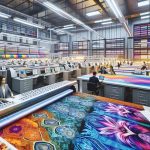You're likely aware that fabric waste is a significant issue in various industries, but have you considered the innovative methods being developed to tackle this problem? From advanced recycling technologies and zero-waste pattern making to digital fabric printing, there's a lot happening to minimize waste and maximize resource efficiency. What's particularly interesting is how these innovations not only benefit the environment but also open up new possibilities for creativity and functionality. Curious about how these advancements are reshaping traditional practices and what this means for future sustainability efforts? Let's explore the details.
Table of Contents
Key Takeaways
- Chemical recycling extracts valuable fibers from fabric waste while maintaining high quality.
- Zero-waste pattern making eliminates fabric waste by maximizing fabric utilization.
- Major fashion brands upcycle discarded materials into new products, reducing waste.
- Digital fabric printing minimizes errors and resource use, enhancing sustainable production.
- Biodegradable materials like organic cotton and bamboo reduce landfill waste and support ecosystems.
Advanced Recycling Technologies
Advanced recycling technologies can greatly lessen fabric waste by transforming discarded textiles into reusable materials. By embracing these cutting-edge methods, you can play an essential role in minimizing the environmental impact of textile production.
One such method, chemical recycling, breaks down fabric at the molecular level, allowing for the extraction and reuse of valuable fibers. Unlike mechanical recycling, which often degrades the quality of the material, chemical recycling maintains the integrity of the fibers, making them suitable for high-quality products.
Textile regeneration is another remarkable innovation that you should consider. This process involves converting waste fabric into new fibers that retain the original material's properties. Textile regeneration not only reduces the need for virgin resources but also markedly cuts down on water and energy consumption.
By implementing these advanced technologies, you're not just disposing of waste but actively contributing to a sustainable cycle of material use.
Mastering these advanced recycling technologies provides a significant advantage in the ever-evolving textile industry. You'll be at the forefront of a movement that prioritizes sustainability without sacrificing quality. Embrace these innovations, and you'll see a tangible reduction in fabric waste, driving a more eco-friendly future.
Upcycling and Repurposing
You can make a significant impact by upcycling and repurposing old fabrics through creative DIY projects.
The fashion industry is also taking steps to embrace sustainable practices, turning waste into fashionable items.
Plus, there are countless home decor ideas that transform fabric scraps into beautiful and functional pieces.
Creative DIY Projects
Often, a bit of creativity can transform fabric scraps into unique and useful items, reducing waste and adding a personal touch to your home. Crafty upcycling and sustainable sewing allow you to breathe new life into otherwise discarded materials.
Imagine turning old jeans into chic tote bags or transforming worn-out shirts into decorative pillows. By engaging in eco-friendly crafting, you not only minimize waste but also create one-of-a-kind pieces that reflect your style.
Embrace fabric reimagining by exploring a variety of DIY projects. You can stitch together a patchwork quilt from fabric remnants, infusing each square with memories and meaning. Small scraps can be crafted into coasters, bookmarks, or even jewelry.
Don't forget about using fabric for non-sewing projects, too—decoupage fabric onto furniture for an innovative twist.
When you immerse yourself in these projects, remember to keep sustainability at the forefront. Use natural, biodegradable threads and avoid synthetic materials whenever possible. Each project not only hones your skills but also contributes to a more sustainable lifestyle.
With a bit of ingenuity, you can master the art of turning fabric waste into valuable, eco-friendly creations.
Fashion Industry Initiatives
Major fashion brands are embracing upcycling and repurposing to combat fabric waste and promote sustainability. You'll find that these initiatives don't just appeal to the eco-conscious; they're fundamentally reshaping the industry. By transforming discarded materials into new, high-quality products, brands are minimizing waste and maximizing resource efficiency.
Fashion industry collaborations are at the forefront of this movement. Leading designers are partnering with textile innovators to create collections that not only look good but also do good. Imagine a jacket made from repurposed denim or a dress fashioned from vintage scarves—each piece tells a story of transformation and responsibility.
Sustainable manufacturing techniques are also critical. You should note that these methods focus on reducing environmental impact right from the design phase. From zero-waste pattern making to using eco-friendly dyes, the industry is setting new standards. Brands like Patagonia and Stella McCartney are pioneers, proving that you don't have to sacrifice style for sustainability.
Home Decor Ideas
Transforming old textiles into chic home decor can breathe new life into your living space while reducing waste. By embracing the art of upcycling, you can create unique, stylish pieces that showcase your creativity and commitment to sustainability. Start with repurposed furniture, turning outdated or worn items into modern masterpieces. Reupholster chairs with vibrant, leftover fabric or stitch together a patchwork quilt to adorn a tired sofa.
Incorporate sustainable accessories to enhance your space without a hefty environmental footprint. Consider crafting decorative pillows from old clothes or converting faded curtains into trendy table runners. Even small scraps can be turned into:
- Wall hangings: Create intricate designs or simple patterns to add a personal touch to your walls.
- Plant pot covers: Use fabric remnants to wrap around plain pots, adding a splash of color to your indoor garden.
- Storage solutions: Sew fabric baskets for organizing odds and ends in a stylish manner.
Zero-Waste Pattern Making
Zero-waste pattern making revolutionizes garment design by utilizing every inch of fabric, eliminating waste entirely. Imagine creating stunning garments without discarding a single scrap. Through meticulous pattern optimization, you can achieve waste reduction and make a significant impact on sustainability.
First, rethink how you approach pattern drafting. Instead of traditional methods that leave offcuts, focus on interlocking pattern pieces like a puzzle. This technique maximizes fabric utilization, reducing textile waste. You'll need to develop a keen eye for spatial arrangement and adaptability to guarantee no material is left unused.
Next, consider the benefits of modular design. By creating interchangeable pattern pieces, you can mix and match to form different garments without generating waste. This method not only saves fabric but also enhances your creative flexibility, allowing you to offer a diverse range of styles with minimal resources.
Lastly, embrace iterative testing. Create prototypes and experiment with various fabric types and layouts. Each iteration brings you closer to perfecting zero-waste patterns. By mastering these techniques, you'll not only contribute to a more sustainable fashion industry but also refine your craft, setting new standards in design excellence.
Digital Fabric Printing
Innovative approaches like zero-waste pattern making can be complemented by digital fabric printing, which further enhances sustainability and creativity in fashion design. You'll notice that digital printing offers a revolutionary way to achieve textile sustainability while reducing the environmental footprint of traditional fabric production methods.
Digital fabric printing allows you to print on demand, which means you only utilize the exact amount of fabric needed for your designs. This not only minimizes waste but also makes sure that you're not stuck with surplus inventory. Additionally, eco-friendly printing technologies use less water and energy compared to conventional dyeing processes, making them a greener choice.
Here's why digital fabric printing is an essential tool for sustainable fashion:
- Precision: Digital printing enables you to create intricate designs with high precision, reducing errors and wastage.
- Efficiency: You can quickly switch designs and colors without the extensive setup required by traditional methods, enhancing your production speed and flexibility.
- Customization: Offer personalized designs to your customers with ease, catering to unique tastes while upholding a sustainable approach.
Smart Textile Design
Smart textile design leverages advanced technology to create fabrics that not only look great but also offer functional benefits like temperature regulation and moisture management. When you incorporate smart textiles into your wardrobe, you're not just wearing clothes; you're wearing innovation. These garments can adapt to your body's needs, keeping you comfortable in any environment.
Interactive wearables take this concept even further. Imagine clothing that can monitor your heart rate, track your movements, or even adjust its properties based on your activity level. These wearables integrate seamlessly into your daily life, providing real-time feedback and enhancing your overall well-being. They're not just gadgets; they're an extension of you.
Eco friendly dyeing technologies also play an essential role in smart textile design. Traditional dyeing methods are notorious for their environmental impact, often involving harmful chemicals and excessive water usage.
Biodegradable Materials
Biodegradable materials offer a promising solution to the growing problem of fabric waste by breaking down naturally and reducing landfill accumulation. When you choose compostable textiles, you're making a significant impact on the environment. These materials decompose naturally, leaving no toxic residues behind.
Eco-friendly fibers are key players in this space. Materials like organic cotton, bamboo, and hemp aren't only biodegradable but also produced through sustainable methods. By opting for these, you contribute to a reduction in the environmental impact of fabric production.
Here are some compelling benefits of opting for biodegradable materials:
- Reduced Landfill Waste: Biodegradable textiles break down over time, decreasing the volume of waste clogging up our landfills.
- Lower Carbon Footprint: Sustainable production methods associated with eco-friendly fibers often require less energy and water.
- Healthier Ecosystems: By avoiding harmful chemicals and pesticides, biodegradable materials support healthier ecosystems and biodiversity.
You're not just making a fashion statement; you're actively participating in a solution to a global challenge. Choosing biodegradable materials means you're supporting a shift towards more sustainable production practices and helping to reduce the long-term environmental impact of fabric waste.
Circular Fashion Models
Circular fashion models offer a transformative approach to minimizing fabric waste by emphasizing reuse, recycling, and the extended lifespan of garments. By integrating these principles, you can significantly lessen waste and contribute to a more sustainable production cycle.
Imagine a wardrobe where every piece has a story and a future beyond its initial use. That's the power of circular fashion.
You'll find that these models prioritize eco-friendly materials right from the design phase. Designers are now crafting clothes that can be easily disassembled and repurposed, ensuring that nothing goes to waste. This approach not only conserves resources but also markedly reduces the environmental footprint of fashion production.
Incorporating circular fashion means you're part of a movement that values every thread and stitch. Brands are increasingly adopting take-back programs where used garments are collected, refurbished, and resold or recycled into new products. This keeps textiles out of landfills and in circulation for as long as possible.
Sustainable Fabric Alternatives
When exploring sustainable fabric alternatives, consider the benefits of organic cotton. The innovations in recycled polyester also play a significant role in reducing environmental impact. Additionally, the advantages of bamboo fabric should not be overlooked. Each option offers unique ways to maintain quality while being eco-friendly.
You'll discover how these materials can transform your approach to fashion.
Organic Cotton Benefits
Embracing natural cotton can significantly reduce your environmental footprint while offering a sustainable alternative to traditional fabrics. By selecting natural cotton, you support eco-friendly farming methods that eliminate the use of harmful pesticides and synthetic fertilizers. This dedication to sustainable agriculture brings numerous soil health benefits, such as enhanced soil fertility and reduced erosion, guaranteeing that the land remains productive for future generations.
Here are some key advantages of natural cotton:
- Environmentally friendly farming: Natural cotton farming practices promote biodiversity and reduce pollution, making it gentler to the environment.
- Soil health advantages: By utilizing organic compost and crop rotation, natural cotton farming improves soil structure and fertility, maintaining a thriving ecosystem.
- Safer for farmers: Natural cotton farming guarantees safer working conditions and fair wages, contributing to the well-being of farming communities.
When you choose natural cotton, you're not just making a fabric decision; you're supporting a comprehensive approach to sustainability that includes environmental stewardship and social responsibility. The benefits go beyond the fabric itself, impacting lives and nurturing the planet.
Recycled Polyester Innovations
Recycled polyester stands out as a game-changer in sustainable fabric alternatives, offering a practical solution to reduce plastic waste and conserve resources. By transforming discarded plastic bottles and other recycled materials into high-quality textiles, you're directly contributing to textile sustainability. This process not only lessens the environmental impact but also provides eco-friendly options for conscious consumers like yourself.
Incorporating recycled polyester into your wardrobe or product line means you're actively reducing the reliance on virgin polyester, which demands significant energy and water resources. Instead, recycled polyester utilizes existing plastic waste, turning it into something valuable and functional. This closed-loop system epitomizes the circular economy, where waste becomes a resource rather than a burden.
When you choose products made from recycled polyester, you're supporting an industry that prioritizes both innovation and sustainability. This material is versatile, durable, and nearly indistinguishable from its non-recycled counterpart, ensuring you don't compromise on quality. Additionally, by embracing recycled materials, you're fostering a market demand that encourages further advancements in eco-friendly options.
Bamboo Fabric Advantages
Bamboo fabric offers another compelling sustainable alternative, boasting benefits that make it an attractive option for eco-conscious consumers like yourself. Unlike conventional textiles, bamboo fabric is produced through a sustainable production process that minimizes environmental impact. This means that choosing bamboo fabric can notably reduce your carbon footprint and contribute to a greener planet.
One of the standout features of bamboo fabric is its eco-friendly nature. Bamboo plants grow rapidly without the need for pesticides or chemical fertilizers, making them an ideal source for eco friendly textiles. Additionally, bamboo fabric is fully biodegradable, ensuring that it won't contribute to landfill waste once it reaches the end of its lifecycle.
Here are some of the key advantages of bamboo fabric:
- Soft and Breathable: You'll find bamboo fabric to be incredibly soft to the touch, often compared to the luxurious feel of silk and cashmere. It's also highly breathable, keeping you cool and comfortable.
- Antibacterial Properties: Bamboo fabric naturally resists bacteria and odors, making it a hygienic choice for clothing and linens.
- Moisture-Wicking: This fabric effectively wicks moisture away from your skin, keeping you dry and fresh throughout the day.
Frequently Asked Questions
How Can Consumers Identify Brands Committed to Reducing Fabric Waste?
You can identify eco-friendly brands by checking their commitment to sustainable fashion trends. Look for transparency in production processes, certifications like GOTS, and recycled materials. Research their sustainability reports and customer reviews for authenticity.
What Role Do Government Policies Play in Minimizing Fabric Waste?
Imagine government regulations as the guiding stars; they set the course for minimizing fabric waste. By enforcing standards and fostering industry partnerships, they guarantee brands navigate responsibly, creating a more sustainable future for all.
Are There Any Community Initiatives Focused on Fabric Waste Reduction?
Yes, you'll find community workshops and recycling programs aimed at fabric waste reduction. Local partnerships and educational campaigns are essential, teaching you sustainable practices and encouraging active participation in reducing fabric waste within your community.
How Can Individuals Reduce Fabric Waste in Their Daily Lives?
You can reduce fabric waste by embracing upcycling projects and choosing sustainable fashion. Repurpose old clothes into new items, shop second-hand, and support brands committed to eco-friendly practices, making a significant impact on waste reduction.
What Are the Economic Benefits of Reducing Fabric Waste for Businesses?
You'll find that reducing fabric waste in your business can enhance your supply chain efficiency. By minimizing waste, you'll achieve significant cost savings, boosting profitability and promoting a more sustainable operational model.
- Tetron Fabric for Marine Applications: Durability and Use Cases - June 18, 2025
- Tetron Fabric for Outdoor Furniture: Weather Resistance and Care - June 18, 2025
- Tetron Fabric for Wall Coverings: Style and Application Tips - June 18, 2025




